A morning walk following the Tierkloof Hiking Trail through a narrow gorge between towering sandstone cliffs was a highlight of our recent stay at Gamkaberg Nature Reserve in the Little Karoo region of the Western Province.
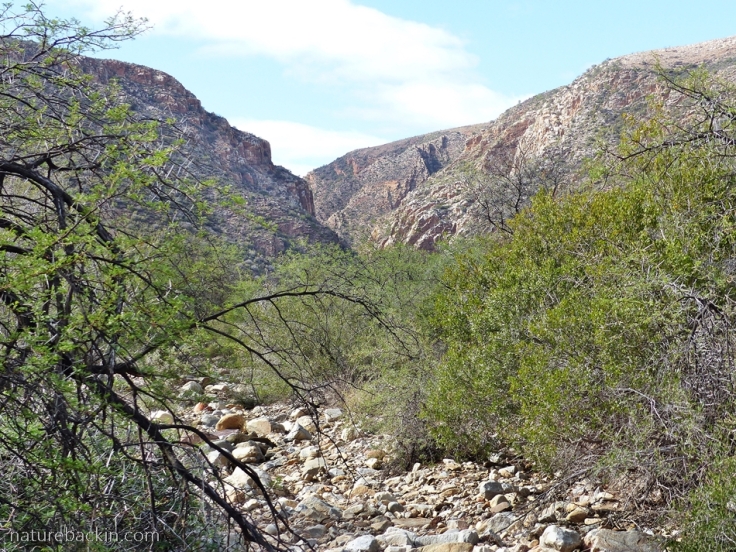
The dry bed of the stream that makes its way through the Tierkloof gorge
The trail is along or alongside a rock-strewn stream bed so hikers have to pick their steps carefully and watch out for loose rocks. Looking down one’s attention can be taken up by the varied and subtly coloured rocks, by small plants, animal spoor in the sandy patches, and insects and the occasional reptile along the path. Looking up one is overwhelmed by towering and craggy sandstone cliffs, decorated with lichen and a diversity of plants that manage to take root in crevices on sheer rock faces.

Impressive sandstone cliffs tower on either side of the gorge
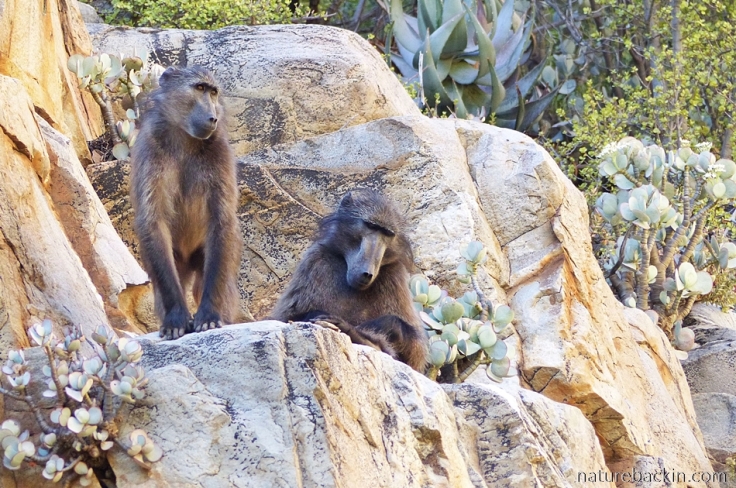
This photo is a bit of a cheat. On this trip we only saw baboons in the distance, so I include this photo taken in Tierkloof on our visit in 2016. It was fairly early in the morning and we saw several baboons taking naps, including the large baboon on the right who is fast asleep

One side of the gorge still in early-morning shadow as we commenced our walk
In the Gamkaberg Nature Reserve there is a marvellous array of vegetation typical of succulent karroo and subtropical thicket biomes, and in deeper sections of the Tierkloof gorge one walks within the cover of evergreen forest remnants.
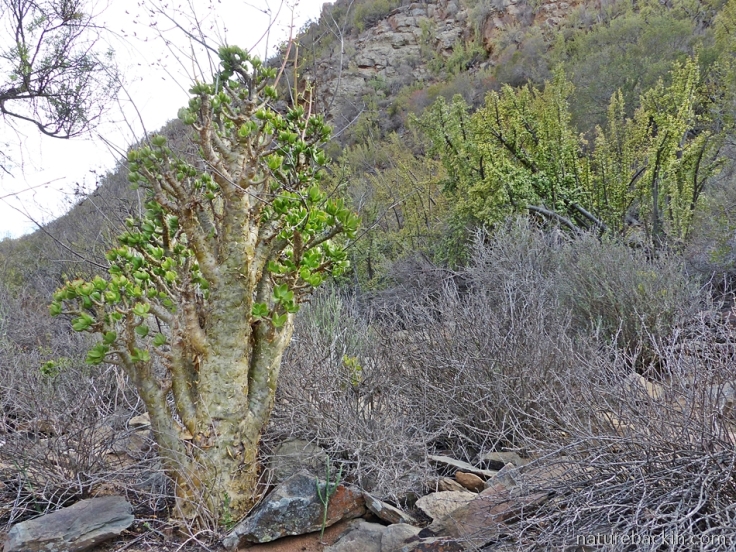
Many of the smaller shrubby plants are brittle and grey and appear to be totally desiccated. In the above photo, a Botterboom is to the left and to the right is the green of a Spekboom.
The thick-stemmed and succulent Botterboom (Tylecodon paniculatus) is one of the eye-catching plants encountered along the trail. Naturally occurring in the dry western parts of southern Africa, the Botterboom (literally ‘Butter tree”) conserves its energy by dropping its leaves in summer – it is able to photosynthesise during the summer months through its yellowy-greenish stems. Not discernible in the photo, this plant is just starting to produce flower buds that will bloom in early summer at the time when it drops its leaves.
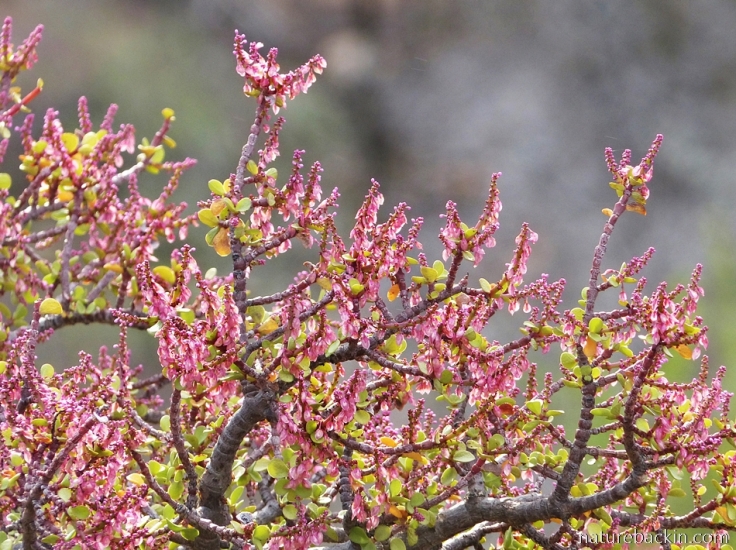
A Spekboom (Portulacaria afra) in flower, which is not something we often see
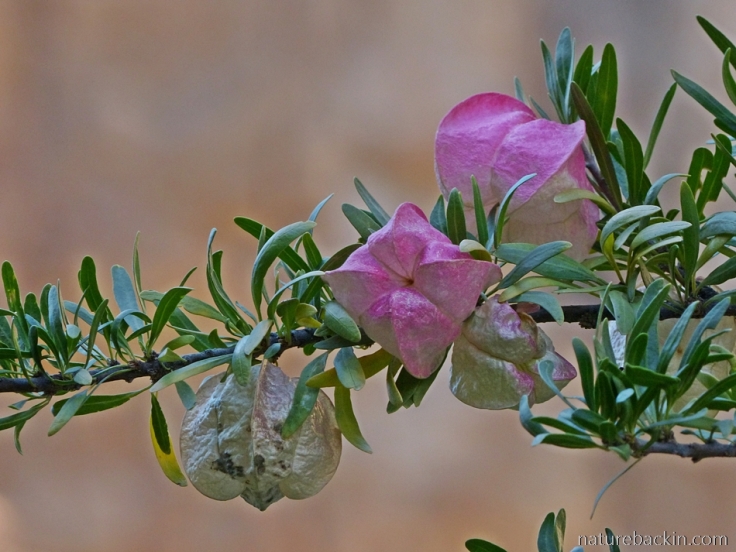
Another striking dry-region plant is Nymania capensis, known as the Chinese lantern tree on account of its decorative papery seed capsules. In Afrikaans it is known as a Klapperbos, with ‘klapper’ referencing the rattling sound when dry seeds are shaken in the seed capsule
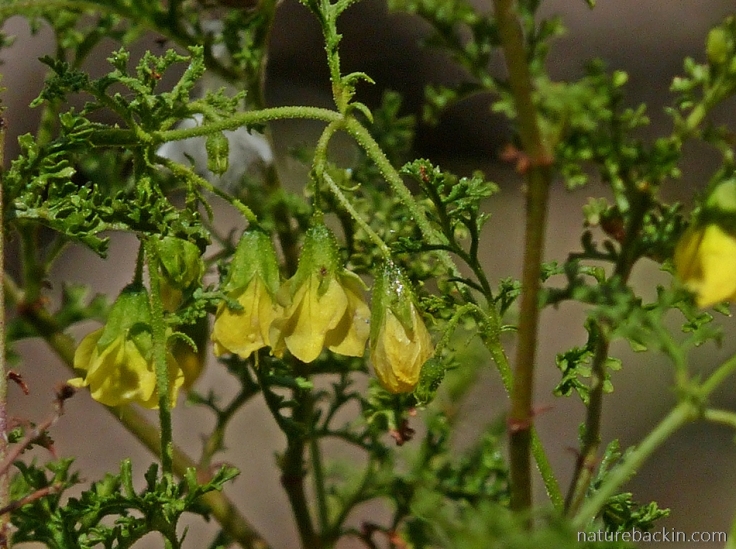
Smaller in scale and growing in protected shaded areas near the stream bed are more tender plants such as Pelargoniums and this low-growing yellow-flowered herb, which I think may be a Hermannia

The rocks in the stream bed appear to be predominately white, but after a while one’s eyes adjust to the palette of pale colours
After about 7 km of walking, I decided to turn back, leaving my two companions to walk on to a large overhang about 2 km further on, freeing me to be able to dawdle and pause to take photographs as much as I liked, and freeing them from frequently stopping to wait for me to catch up!
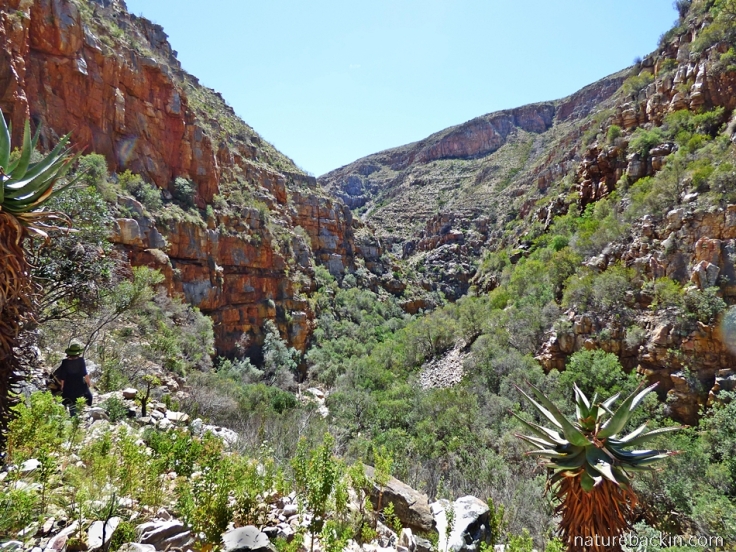
This photo was taken by my husband further up the gorge than I ventured
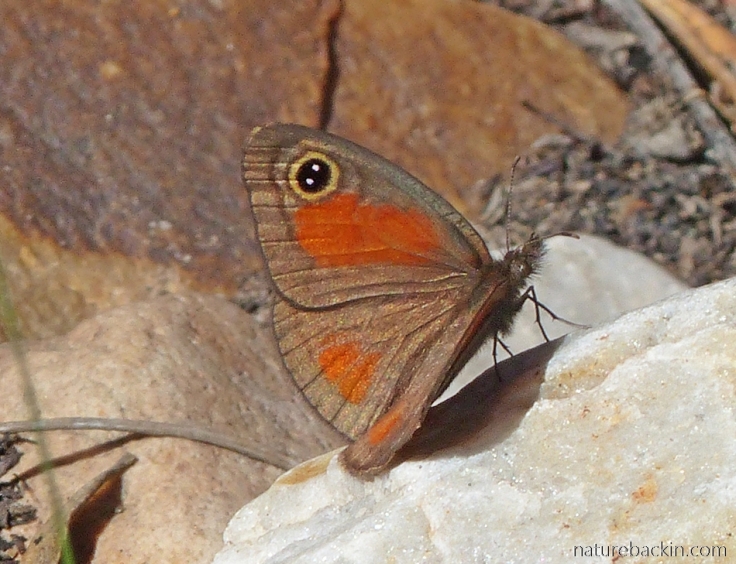
While retracing my steps back down the gorge, pausing to look at the multitude of rocks and pebbles, I spotted this lovely butterfly – one of the species of butterfly known as Browns

As I walked slowly along the gorge this hoverfly flew up alongside me and hovered at just below my eye level, giving me time to snap this photo!
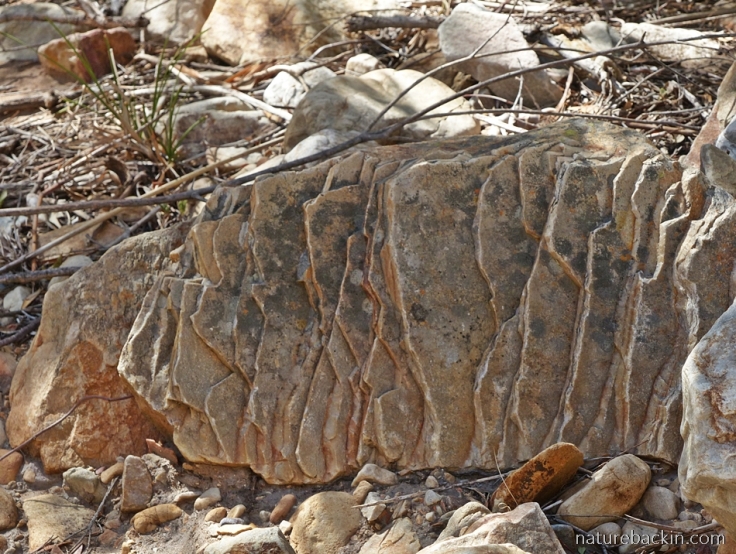
One of the many interesting rocks on the banks of the stream bed

Although the stream was mostly dry, we did come across water in one rock pool near a small weir
On returning to the rock pool on my way back, I sat down on the ground concealing myself behind a buddleia bush, to wait to see if anything may come along to drink. After a while Cape Siskins and Rock Buntings came down to drink and also two incredibly large and iridescent wasps that sounded like small airplanes when they flew. It was lovely to sit quietly and listen to the coos of the Speckled Pigeons echoing across the gorge.

A Cape Bunting, half-aware of my presence, coming down to the rockpool to drink
Continuing on my way back to camp the gorge widens out and at times the path diverges out onto a sandier route, revealing more insects and more interesting rocks (the photographs of which I am not including as this post is getting to be way too long!).

One of the more interesting insects that I came across was this seriously beautiful Thread-waisted Wasp as she was busy excavating a nest before provisioning it with prey for her progeny to eat after they hatch
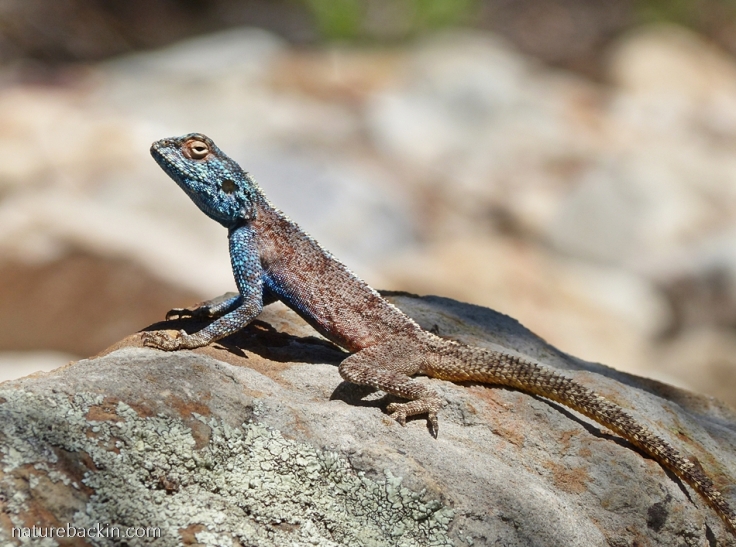
I was completely charmed by this Southern Rock Agama whom I first spotted under a bush next to the path. After I stopped he made his way onto a large rock and after doing some press-ups, eyeing me candidly all the while, he lay down flat to soak up some warmth from the rock. The blue colouration and the white dorsal stripe (just visible) are characteristic of male Southern Rock Agamas in the breeding season
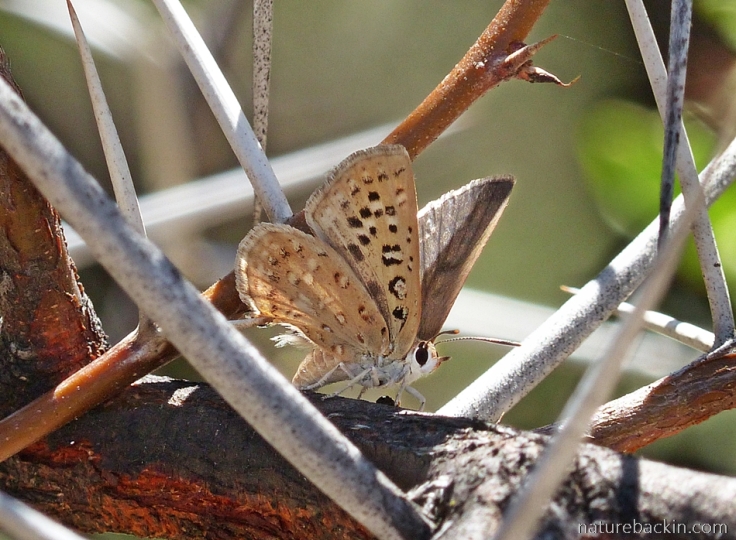
A Silver-spotted Grey butterfly laying its eggs on a Sweet Thorn branch
A few bends in the path after spending time with the agama, and as the temperature started to rise late in the morning, I noticed a tiny butterfly ovipositing on a branch of a small Sweet Thorn tree. In the photo the silver thorns look like pillars, conveying how small the butterfly actually is. I think this butterfly is a Silver-spotted Grey, and in fact the Sweet Thorn (Vachellia karroo formerly Acacia karroo) is one of only three larval host plants for this butterfly.
The Sweet Thorn grows abundantly in the Karoo region occurring also across different habitats in southern Africa and as far north as Angola and Zambia. In arid areas its presence is considered to be an indicator of both underground and surface water. It was indeed sobering on our recent road trip to see Sweet Thorn trees collapsed and dead in some of the areas worst affected by the prolonged drought.
Despite the thorns, the Sweet Thorn is an important fodder tree for both wild and domestic animals. They feed on the leaves, the yellow pompom flowers (in summer) and the seedpods, thus playing a role in seed dispersal.
The Sweet Thorn gets its name from the sweet gum exuded from damaged bark. The gum used to be exported as “Cape Gum” and it was used in making confectionary. It is similar to “Gum Arabica”, which is taken from other species of trees, including other acacia species.
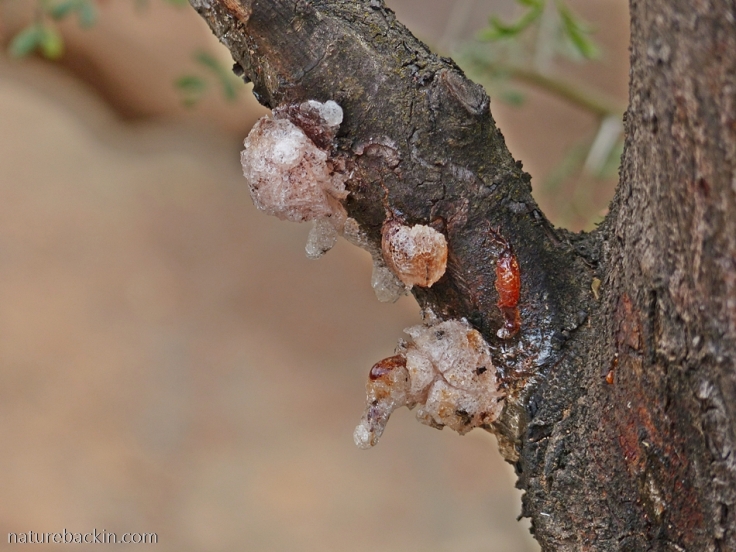
A Sweet Thorn growing near our tent back at camp had exuded gum, which had hardened into sugary looking lumps. I tasted a morsel that had fallen to the ground and found it to be so mildly sweet as to be almost tasteless
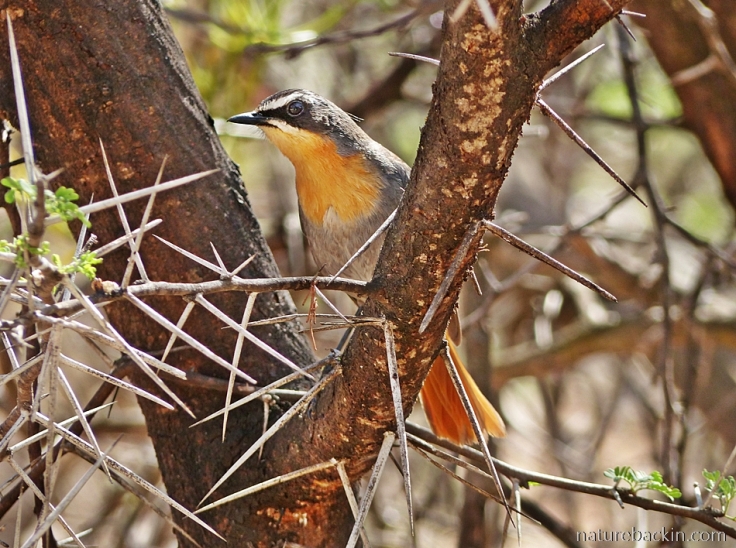
A Cape Robin-chat perched in one of the many Sweet Thorns growing in the camp

A pair of very confiding Southern Boubous hung out at the camp with its thoughtfully provided birdbath. Other birds visiting the camp included Cape Bulbul, Familiar Chat, Fiscal Flycatcher, Cape Bunting and Speckled Pigeons
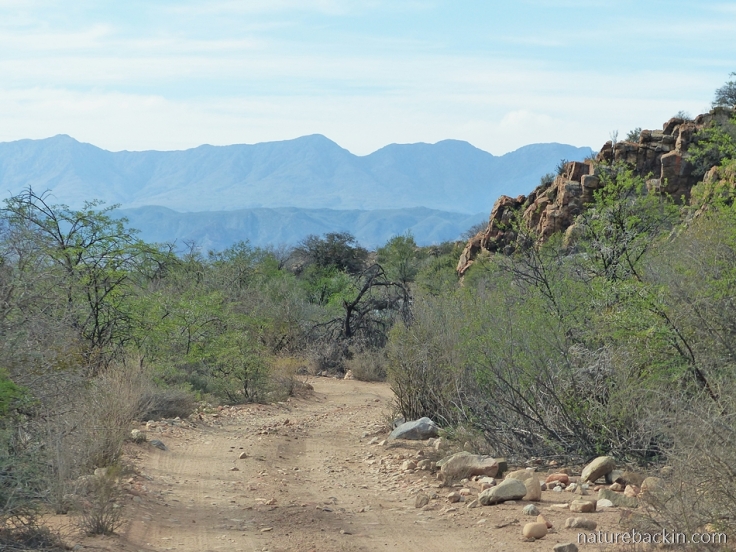
A view down the track that leads to Fossil Ridge and two other accommodation sites at Gamkaberg Nature Reserve
Fossil Ridge Eco Lodge tented camp, where we stayed, can accommodate four people in two sleeping tents. It also has a tent housing a kitchen and dining area, and a brick bathroom block with two bathrooms, each with a wash basin and a shower (with hot water provide by a gas geyser) and each with an ingenious waterless eco-loo.
Lighting at the camp is solar powered. Staff and tourist facilities are supplied with borehole water that is clean and slightly brackish. We made sure to bring our own jerry can filled with drinking water from home. Despite the prolonged drought the borehole water supply is considered to be reliable, although of course water should be used sparingly. Each camp has a small plunge pool with a plant-filled filtration system, but because of the drought the plunge pools have been drained and each pool is covered with a net. For photographs of the camps and information on accommodation options at Gamkaberg Nature Reserve see here
The attractive accommodation at Gamkaberg is thoughtfully designed to be eco-friendly, and it is comfortable, tasteful, practical and maintained to a very high standard. The staff evidently take enormous pride in their work and they are extremely helpful and hospitable.
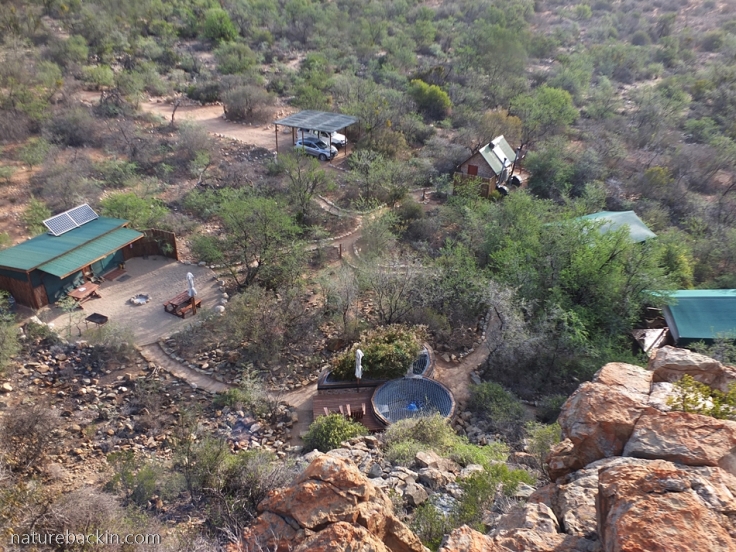
We climbed the ridge alongside the camp from where my husband took this photo of Fossil Ridge camp on our first evening there, despite being buffeted by strong winds.
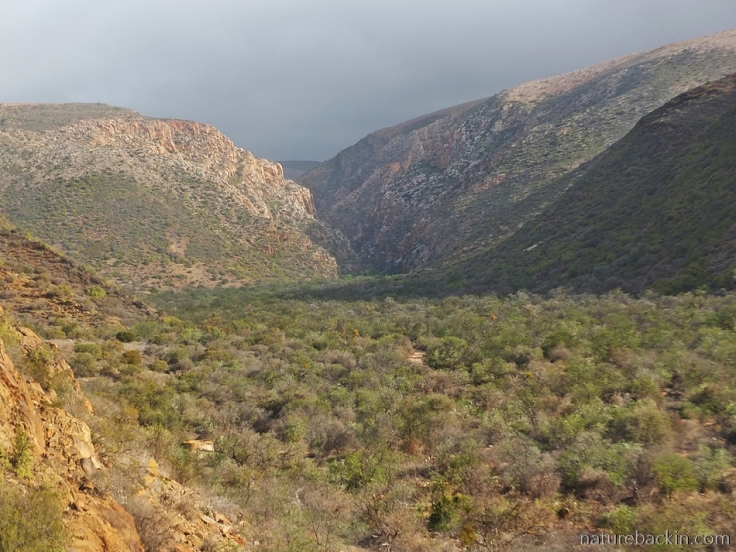
Taken on our first evening, this is the view from the ridge above the camp towards Tierkloof gorge and approaching rain clouds that produced no real rain, However, that night the temperature dropped to a chilly 6°C
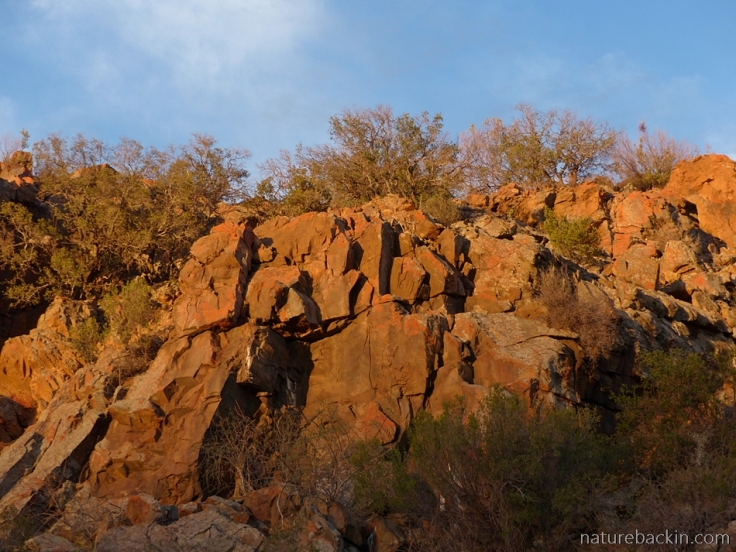
The sandstone ridge above the camp, glowing in late afternoon sunshine – photo taken from outside the kitchen
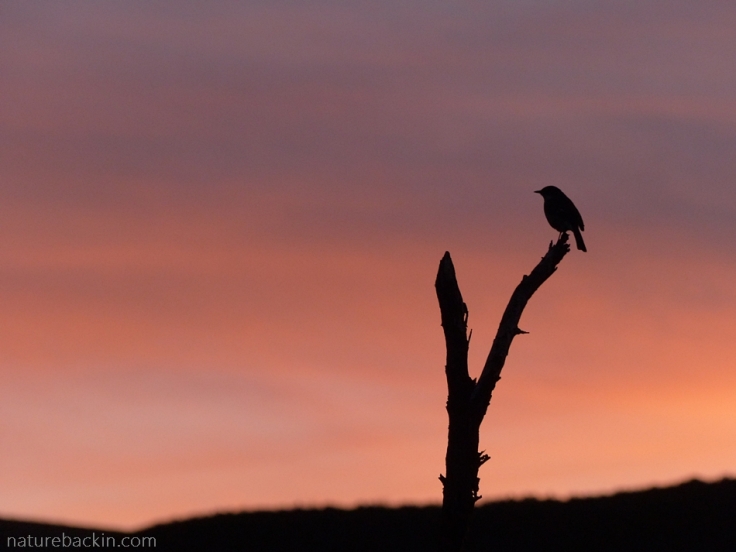
As we sat around the camp fire I took this photo of a Fiscal Flycatcher silhouetted against the sunset on our second and last night at Gamkaberg Nature Reserve
Posted by Carol

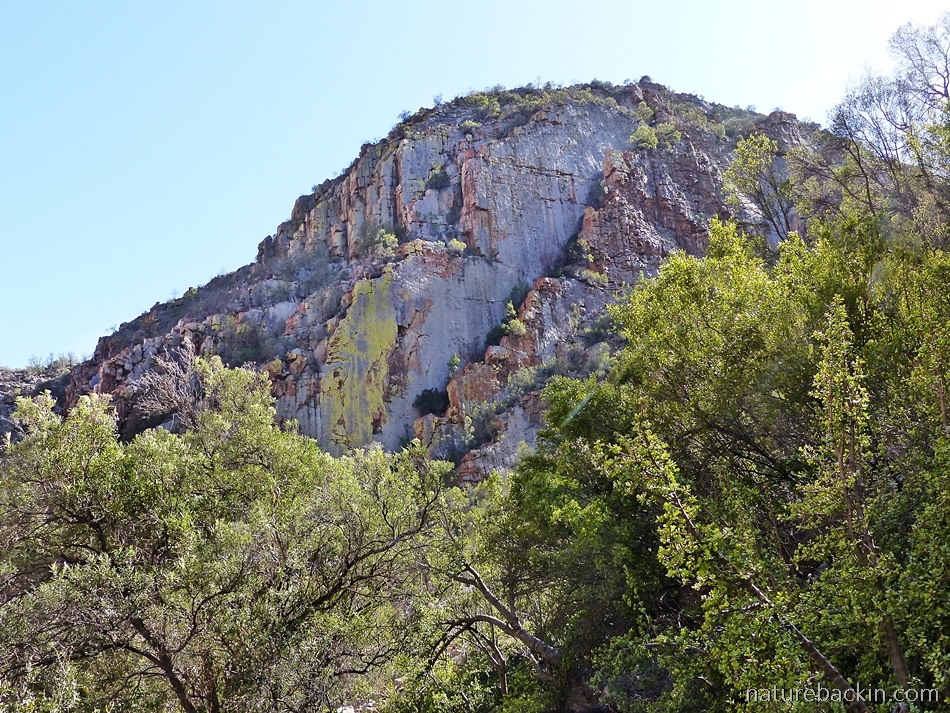







November 25, 2019 at 2:43 am
In an odd sort of way, your trip seems to echo bits of the one we took. The steep cliffs and and gorges… but the vegetation and creatures (that hover fly shot is utterly amazing!) are quite unique to me. Thank you for taking me along on your journey.
I’ve seen our lizards here doing ‘press ups’ and have wondered why they do that? Best guess would be to cool off maybe? But I’m too lazy to follow that thread. I’ll leave it as one of life’s little mysteries for now and move on to catching up on so much blogging that’s been waiting for me to get back to it!
(Yay! I’m doing much better. Just hoping I didn’t overdo it washing the kitchen floor today! I’ve never had an excess of patience! 😀 )
LikeLiked by 1 person
November 25, 2019 at 8:18 am
Yes there are coincidences although the differences are noticeable to as you say.
Re lizards, I gather that push-ups and head bobbing can signal territorial defence (perhaps that is why the agama was doing that with me sitting in proximity – although he moved out into the open while I was watching) and are also used as displays during courting behaviour towards both rivals and potential consorts.
So glad you are feeling better, but then one is tempted to overdo it!! Take patient care of yourself!
LikeLike
November 16, 2019 at 7:39 am
It’s a wonderful place! I liked to come with you.
LikeLike
November 15, 2019 at 12:26 pm
What an amazing place.
LikeLiked by 1 person
November 15, 2019 at 5:45 pm
Thanks Edith – those towering cliffs, complex rock formations and the diversity of life in an arid zone are indeed amazing.
LikeLike
November 15, 2019 at 11:11 am
What a wonderful photo essay capturing the great vistas and the minute details and all things between. I am left with a sense of peace from your depiction of this place, timeless and free from the noise of the 21st century. Beautiful, Carol!
LikeLiked by 1 person
November 15, 2019 at 5:44 pm
Thanks for the lovely comment Sandra – it is peaceful and there is a sense of timelessness there in among those ancient rock formations.
LikeLiked by 1 person
November 15, 2019 at 8:08 am
You illustrate so well the worth of sitting still, waiting and watching.
LikeLiked by 1 person
November 15, 2019 at 5:34 pm
Indeed, sitting quietly is rewarding as waiting quickly turns into noticing all sorts of things that were previously overlooked.
LikeLiked by 1 person
November 15, 2019 at 8:00 am
Gamkaberg and the Tierkloof trail are now firmly on my “must see” list. Thank you for your enticing post and beautiful photographs. You make the magic of the Karroo jump off the screen
LikeLiked by 1 person
November 15, 2019 at 5:29 pm
Great that you plan to visit Gamkaberg – I rate it very highly and I am glad that the post is enticing.
LikeLiked by 1 person
November 15, 2019 at 7:01 am
A wonderful account of a trip that is so very different from any experience I have of European upland scenery, where absence of water is rarely a problem. Great shots describing this area too.
LikeLiked by 1 person
November 15, 2019 at 5:22 pm
Thanks Margaret. It is an interesting place – the diversity in such an arid area is incredible.
By contrast I have read a little about the flooding and ongoing rains in Yorkshire, Lincolnshire and elsewhere. I hope that you are safe where you are, but even so it sounds to be miserable and worrying.
LikeLiked by 1 person
November 15, 2019 at 8:19 pm
It is miserable – luckily not for us. But plans for building on floodplains continue….
LikeLiked by 1 person
November 15, 2019 at 6:20 am
Looks like a great camp and a great hike. Even in the drought, there’s so much life that you have captured so well. I look forward to seeing more of your travel photos.
LikeLiked by 1 person
November 15, 2019 at 2:03 pm
It is a great camp and the hiking trail is so varied and interesting even within a small area with gorge offering quite a bit of protection from extremes.
There will be more travel photos to follow 🙂
LikeLiked by 1 person
November 16, 2019 at 3:58 pm
Gorges and valleys are great for that. There are some tropical gardens in Cornwall, where I used to live, that do well in the deep valleys.
LikeLiked by 1 person
November 20, 2019 at 2:03 pm
I recall reading about such gardens in Cornwall. How interesting that the valleys provide protection to make such tropical plantings possible.
LikeLiked by 1 person
November 21, 2019 at 5:58 am
The protection is one thing, but the other big factor is that, if there is cold weather, the cold air rolls down the valleys and out to sea, so the plants are only briefly exposed to those conditions.
LikeLiked by 1 person
November 15, 2019 at 2:22 am
Thank you for showcasing this amazingly beautiful piece of South Africa, Carol! It definitely seems like just the place to head for when the city-crowds start driving you mad.
And freezing that fly in mid-flight took some doing – brilliantly done!
LikeLiked by 1 person
November 15, 2019 at 2:01 pm
It is a lovely place, and the staff there deserve the support of visitors to the immaculate camps. It is very peaceful and makes for a lovely retreat.
The fly practically froze itself in mid-flight and as it hovered in one spot for so long I felt obliged to take its picture 🙂
LikeLiked by 1 person
November 16, 2019 at 2:51 am
Sadly, all our reserves are hopelessly underfunded by the state and rely on tourism to fill their coffers. Gamkaberg’s going about it in the right way by providing comfortable yet affordable accommodation that is also friendly to the environment.
LikeLiked by 1 person
November 20, 2019 at 1:57 pm
Yes it is sad. It is a pity that in the KZN reserves as far as I know, any income generated in the reserves goes to the Provincial coffers for general redistribution from there, which does not provide the parks staff with much of an incentive.
I agree that Gamkaberg provides an excellent model.
LikeLiked by 1 person
November 15, 2019 at 12:17 am
Wonderful photos, Carol. I love learning about this area and the many species that make it their home.
LikeLiked by 1 person
November 15, 2019 at 1:43 pm
Thank you Eliza, it is a very fascinating area.
LikeLike
November 14, 2019 at 8:44 pm
This is a marvellous post, Carol. How much do you love this land! Thank you for sharing its many treasures.
LikeLiked by 1 person
November 15, 2019 at 1:39 pm
Thank you Tish – it is lovely to share some of its treasures. Nice that my affection for the place comes through 🙂
LikeLiked by 1 person